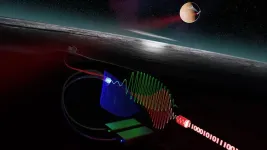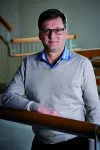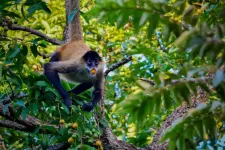(Press-News.org) In space exploration, long-distance optical links can now be used to transmit images, films and data from space probes to Earth using light. But in order for the signals to reach all the way and not be disturbed along the way, hypersensitive receivers and noise-free amplifiers are required. Now, researchers at Chalmers University of Technology, in Sweden, have created a system that, with a silent amplifier and record-sensitive receiver, paves the way for faster and improved space communication.
Space communication systems are increasingly based on optical laser beams rather than radio waves, as the signal loss has been shown to be less when light is used to carry information over very long distances. But even information carried by light loses its power during the journey, and optical systems for space communication therefore require extremely sensitive receivers capable of sensing signals that have been greatly weakened before they finally reach Earth. The Chalmers researchers' concept for optical space communication opens up new communication opportunities – and discoveries – in space.
"We can demonstrate a new system for optical communication with a receiver that is more sensitive than has been demonstrated previously at high data rates. This means that you can get a faster and more error-free transfer of information over very long distances, for example when you want to send high-resolution images or videos from the Moon or Mars to Earth," says Peter Andrekson, Professor of Photonics at Chalmers and one of the lead authors of the study, which was recently published in the scientific journal Optica.
Silent amplifier with simplified transmitter improves communication
The researchers' communication system uses an optical amplifier in the receiver that amplifies the signal with the least possible noise so that its information can be recycled. Just like the glow of a flashlight, the light from the transmitter widens and weakens with distance. Without amplification, the signal is so weak after the space flight that it is drowned out by the electronic noise of the receiver. After twenty years of struggling with disturbing noise that impaired the signals, the research team at Chalmers was able to demonstrate a noise-free optical amplifier a few years ago. But until now, the silent amplifier has not been able to be used practically in optical communication links, as it has placed completely new, significantly more complex, demands on both transmitter and receiver.
Due to the limited resources and minimal space on board a space probe, it is important that the transmitter is as simple as possible. By allowing the receiver on Earth to generate two of the three light frequencies needed for noise-free amplification, and at the same time allowing the transmitter to generate only one frequency, the Chalmers researchers were able to implement the noise-free amplifier in an optical communication system for the first time. The results show an outstanding sensitivity, while complexity at the transmitter is modest.
"This phase-sensitive optical amplifier does not, in principle, generate any extra noise, which contributes to a more sensitive receiver and that error-free data transmission is achieved even when the power of the signal is lower. By generating two extra waves of different frequencies in the receiver, rather than as previously done in the transmitter, a conventional laser transmitter with one wave can now be used to implement the amplifier. Our simplification of the transmitter means that already existing optical transmitters on board satellites and probes could be used together with the noise-free amplifier in a receiver on Earth," says Rasmus Larsson, Postdoctoral Researcher in Photonics at Chalmers and one of the lead authors of the study.
Can solve problematic bottleneck
The progress means that the researchers' silent amplifiers can eventually be used in practice in communication links between space and Earth. The system is thus poised to contribute in solving a well-known bottleneck problem among space agencies today.
NASA talks about 'the science return bottleneck', and here the speed of the collection of scientific data from space to Earth is a factor that constitutes an obstacle in the chain. We believe that our system is an important step forward towards a practical solution that can resolve this bottleneck," says Peter Andrekson.
The next step for the researchers is to test the optical communication system with the implemented amplifier during field studies on Earth, and later also in communication links between a satellite and Earth.
More about the scientific article
The study "Ultralow noise preamplified optical receiver using conventional single wavelength transmission" has been published in Optica and is written by Rasmus Larsson, Ruwan U Weerasuriya and Peter Andrekson. The researchers are active at Chalmers University of Technology and the University of Moratuwa, Sri Lanka.
The development of the technology has been done at Chalmers University of Technology and the research has been funded by the Swedish Research Council.
For more information, please contact:
Rasmus Larsson, Postdoctoral Researcher, Division of Photonics, Department of Microtechnology and Nanoscience, Chalmers University of Technology
rasmus.larsson@chalmers.se
Peter Andrekson, Professor, Division of Photonics, Department of Microtechnology and Nanoscience, Chalmers University of Technology
peter.andrekson@chalmers.se, +46 31 772 16 06
The contact persons both speak English and Swedish. They are available for live and pre-recorded interviews. At Chalmers, we have podcast studios and broadcast filming equipment on site and would be able to assist a request for a television, radio or podcast interview.
Illustration caption: In the new communication system from researchers at Chalmers University of Technology, in Sweden, a weak optical signal (red) from the spacecraft's transmitter can be amplified noise-free when it encounters two so-called pump waves (blue and green) of different frequencies in a receiver on Earth. Thanks to the researchers' noise-free amplifiers in the receiver, the signal is kept undisturbed and the reception on Earth becomes record-sensitive, which in turn paves the way for a more error-free and faster data transmission in space in the future.
Illustration credit: Chalmers University of Technology | Rasmus Larsson
END
Faster space communication with record-sensitive receiver
2024-10-30
ELSE PRESS RELEASES FROM THIS DATE:
New study shows that university students experienced increased psychological distress during COVID-19, but utilized fewer support services
2024-10-30
Embargoed Until 10/30/24 at 7 am
PhD in Public Health candidate Elaine Russell and her mentor Kenneth Griffin, professor in the department of Global and Community Health, in George Mason University’s College of Public Health, worked with Tolulope Abidogun, also a PhD in Public Health student, and former Global and Community Health professor Lisa Lindley, now of Lehigh University, to analyze data from the American College Health Association National College Health Assessment (ACHA-NCHA III) in an effort to understand how university ...
Camera trap study reveals a “vital sanctuary” for wildlife and endangered species in Cambodia’s Central Cardamom Mountains
2024-10-30
PHNOM PENH, Cambodia (October 30, 2024) – The first-ever camera trap study of the Central Cardamom Mountains Landscape has recorded 108 species, 23 of which are listed at risk (Vulnerable or above) on the IUCN Red List, underscoring the significance of the region as a global stronghold for biodiversity and rare and threatened species.
Editors please note: Use these links to access camera trap footage and the full report.
The report, released today by the Cambodian Ministry of Environment (MoE), the United States Agency ...
Buried Alive: Carbon dioxide release from magma deep beneath ancient volcanoes was a hidden driver of Earth’s past climate
2024-10-30
An international team of geoscientists led by a volcanologist at Rutgers University-New Brunswick has discovered that, contrary to present scientific understanding, ancient volcanoes continued to spew carbon dioxide into the atmosphere from deep within the Earth long past their period of eruptions.
In doing so, the research team has solved a long-standing mystery over what caused prolonged episodes of warming during turning points in Earth’s climate history. The work is detailed in today’s issue of the journal Nature Geoscience.
“Our ...
New genetic web tool to help restore climate-resilient marine ecosystems
2024-10-30
In the face of increased human pressures and climate change, a team of Australian scientists led by Dr Georgina Wood at Flinders University have launched a new online tool to assist marine managers and restoration experts to bolster the resilience of marine habitat-forming species.
The ‘Reef Adapt’ initiative, developed by experts from the NSW Department of Primary Industries and Regional Development (NSW DPIRD), Flinders University and The University of Western Australia (UWA), aims to expand the tools available to promote diverse, adaptable and resilient ecosystems.
Described in a new article in Communications Biology, Reef Adapt harnesses genetic data ...
Three pathways to achieve global climate and sustainable development goals
2024-10-30
"Sustainable development pathways are strategies that prevent dangerous climate change while at the same time moving towards a world that allows people to prosper on a healthy planet,” explains Bjoern Soergel, scientist at the Potsdam Institute for Climate Impact Research PIK and lead author of the study published in Environmental Research Letters. This is the essence of the 17 SDGs agreed by the United Nations in 2015. “Our analysis shows that all three sustainable development pathways are far more effective than our current ‘business as usual’. They drive substantial progress towards the SDGs, for example reducing the number of people in extreme poverty ...
Giant rats could soon fight illegal wildlife trade by sniffing out elephant tusk and rhino horn
2024-10-30
In the past, African giant pouched rats have learned to detect explosives and the tuberculosis-causing pathogen. Now, a team of researchers have trained these rats to pick up the scent of pangolin scales, elephant ivory, rhino horn, and African blackwood. These animals and plants are listed as threatened and at high danger of extinction.
“Our study shows that we can train African giant pouched rats to detect illegally trafficked wildlife, even when it has been concealed among other substances,” ...
Spin current observations from organic semiconductor side
2024-10-30
Electrons spin even without an electric charge and this motion in condensed matter constitutes spin current, which is attracting a great deal of attention for next-generation technology such as memory devices. An Osaka Metropolitan University-led research group has been able to gain further insight into this important topic in the field of spintronics.
To investigate the characteristics of spin currents, OMU Graduate School of Science Professor Katsuichi Kanemoto’s group designed a multilayer device consisting of a ferromagnetic layer and an organic semiconductor ...
Alcohol consumption among non-human animals may not be as rare as previously thought, say ecologists
2024-10-30
Anecdotes abound of wildlife behaving “drunk” after eating fermented fruits, but despite this, nonhuman consumption of ethanol has been assumed to be rare and accidental. Ecologists challenge this assumption in a review publishing October 30 in the Cell Press journal Trends in Ecology & Evolution. They argue that since ethanol is naturally present in nearly every ecosystem, it is likely consumed on a regular basis by most fruit- and nectar-eating animals.
“We're moving away from this anthropocentric view that ethanol is just something ...
Survey: Dangerous gap in knowledge about pancreatic cancer among adults under age 50
2024-10-30
While pancreatic cancer rates are rising in people under age 50, a new survey conducted by The Ohio State University Comprehensive Cancer Center – Arthur G. James Cancer Hospital and Richard J. Solove Research Institute (OSUCCC – James) shows most people continue to believe that pancreatic disease affects only the elderly – and that there is nothing they can do to reduce their risk.
For this survey, respondents were asked about risk factors for pancreatic cancer. More than half (53%) of adults under age 50 said they would not recognize the early signs or symptoms of the disease, and more than one third (37%) believe there is ...
Women entering menopause later in life at greater risk for asthma
2024-10-30
CLEVELAND, Ohio (Oct. 30, 2024)—Many studies suggest that an earlier age at menopause is more detrimental to a woman’s health, leading to an increased risk for adverse health conditions such as heart disease, diabetes, osteoporosis, and depression, among others. However, a new study is linking a later age at natural menopause with a greater risk for asthma. Results of the study are published online today in Menopause, the journal of The Menopause Society.
Asthma is a common, chronic disease affecting more than 300 million people worldwide. The prevalence of asthma ...








